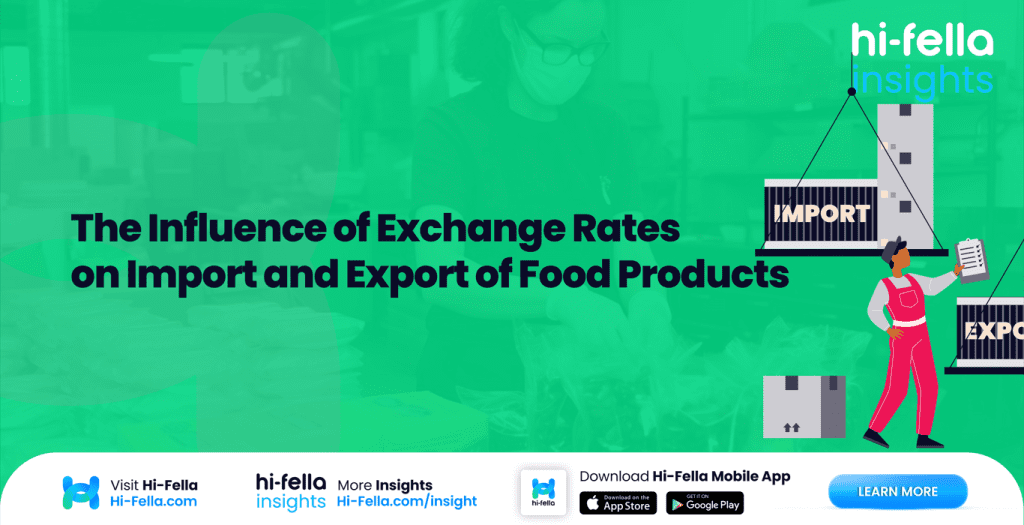Exchange rates don’t just belong in trading floors and economic textbooks—they have real, everyday consequences for people moving actual goods across borders. If you’re in the business of importing or exporting food products, currency fluctuations can quietly reshape your costs, margins, competitiveness, and even your strategic decisions.
And in a globalised food economy where mangoes come from India, cheese from France, and coffee from Ethiopia, ignoring exchange rate dynamics is like sailing without checking the tide.
Let’s break down how exchange rates influence global food trade—and what smart businesses can do about it.
When Your Currency Drops: Exporters Smile, Importers Sweat
When a country’s currency weakens relative to others, it often gives local exporters a competitive advantage. This is especially true in the food industry, where global buyers are constantly looking for value. A weaker currency effectively lowers the price of exports in foreign markets, making them more appealing. For example, if the Malaysian ringgit falls against the Singapore dollar, frozen durian exporters in Malaysia may see a spike in orders from Singaporean buyers, who can now purchase more for less.
This advantage often translates into real business opportunities. Exporters may use this period to scale up production, clear stock, or penetrate new markets that were previously price-sensitive. Products that were once considered premium or niche may suddenly become viable in price-driven segments overseas. The overall impact is an increase in volume and, potentially, the opening of long-term trade relationships that can extend beyond the currency fluctuation.
However, the story isn’t so rosy for food importers. That same weaker domestic currency means that importing food becomes significantly more expensive. Whether it’s French cheese, Australian lamb, or Italian olive oil, the landed cost of those products rises sharply. For local importers operating on tight margins, this can be a real squeeze, forcing them to choose between raising retail prices or absorbing the losses.
This price pressure doesn’t just affect businesses—it trickles down to consumers. Imported goods become less accessible to middle-income shoppers, potentially shifting demand toward local alternatives. In some cases, importers may scale back on variety or volume, affecting everything from supermarket shelves to restaurant menus. It’s a real-time example of how currency dynamics directly influence what ends up on the table.
So while exporters may welcome a weaker currency, importers often face difficult trade-offs. That’s why businesses involved in international food trade need to closely monitor exchange rates and understand how these shifts affect both cost structures and consumer behaviour. Currency movements aren’t just financial—they influence supply, demand, pricing, and strategic planning across the entire food value chain.
When Your Currency Strengthens: Importers Rejoice, Exporters Rethink
Flip the scenario. A stronger domestic currency makes imported food cheaper. Importers love this—it helps reduce landed costs, expand product variety, and potentially improve profit margins. It can also boost affordability for consumers, especially on premium or seasonal products.
But for food exporters, this strength can be a strategic headache. A higher currency makes your goods more expensive overseas, especially if your competitors in other countries are pricing in weaker currencies. You may need to either reduce prices (and accept thinner margins) or justify your higher price through branding, quality, or logistics advantages.
That’s where pricing strategy, trade support tools, and market insight come into play.
Exchange Rate Volatility and Contract Risk
It’s not just about whether a currency rises or falls—it’s about how often and how unpredictably it moves. Volatility in exchange rates adds risk to long-term contracts, especially when deals are priced in foreign currency.
Imagine an Indonesian coffee exporter locking in a deal to supply beans to a buyer in Japan, priced in yen. If the rupiah suddenly strengthens after the agreement is signed, the exporter earns less in rupiah than expected—even if the price in yen stays fixed.
To manage this, savvy businesses use hedging tools—like forward contracts or currency swaps—to lock in exchange rates and minimise surprises. It’s not just about protecting revenue; it’s about ensuring predictability in a volatile environment.
Price Competitiveness and Regional Trade Advantage
Exchange rates also affect how countries compete regionally. If two countries are exporting similar products—say, Thai and Vietnamese rice—the one with the weaker currency often has a pricing edge. Over time, this can shift buyer preferences, contract volumes, and even supply chain investment.
This is especially true for commodity food products, where buyers are price-sensitive and brand loyalty is low. In contrast, branded or specialty food products have more room to weather exchange rate shifts—because the perceived value is based on more than price alone.
The lesson? Know where your product sits on the value spectrum—and price with currency dynamics in mind.
The Role of Currency in Trade Strategy
Exchange rates aren’t just something you react to—they should shape your broader trade strategy. For exporters, that could mean:
- Timing shipments during favourable currency periods
- Diversifying into multiple markets to reduce dependency on one currency zone
- Pricing in your home currency whenever possible to reduce exposure
For importers, it might mean:
- Negotiating flexible payment terms to account for volatility
- Consolidating orders to benefit from favourable exchange windows
- Exploring dual sourcing to balance costs across currencies
And for both, staying close to trade news, currency forecasts, and platforms that help you adapt quickly is key.
Why Exporters and Importers Need Better Tools and Platforms
Exchange rates are dynamic. But many food businesses still operate with static pricing models, outdated contracts, and little visibility into their exposure. That’s where smarter platforms come into play.
hi-fella offers more than just trade listings. It gives exporters and importers access to global market intelligence, exhibition opportunities to test new regions, and real-time support to navigate trade complexity—including currency-related risks. Whether you’re exploring new markets or trying to optimise trade terms, hi-fella is built to help you move faster and smarter.
It’s Not Just Currency—It’s Strategy
At the end of the day, exchange rates are one of many levers in the import-export game—but they’re one of the most powerful. They shape competitiveness, influence buyer decisions, and ripple across supply chains. Understanding how to price, position, and plan with currencies in mind is essential to staying agile in global food trade.
So if you’re exporting gourmet snacks to the Middle East, or importing organic grains from Eastern Europe, don’t just watch the exchange rate—build a strategy around it.
And when you’re ready to take that strategy global, connect with hi-fella—your go-to platform for smart trade, global exhibitions, and export-import support designed for businesses ready to think bigger.








